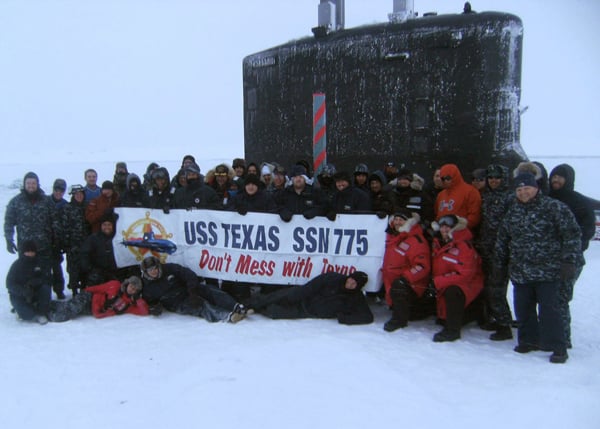
© COMSUBPAC Public Affairs
Last week, it was reported that an American submarine, the USS Texas (SSN 775), surfaced near the North Pole in mid-October. The submarine, part of the Virginia class, was the first ship in its kind to do so. It was taking part in an ICEX, or ice exercise. After surfacing, the submarine stayed moored to the ice for 24 hours. Ens. James Robinson, Supply Officer of USS Texas, said in the Navy press release:
“Activities on the ice included a very special re-enlistment ceremony for 12 crew members and a pinning ceremony in which one crew member received his submarine warfare qualification dolphins, as well as some down time to play touch football in the five degree weather.”
The submarine then sailed on to warmer climes in Honolulu, Hawaii, where it will be stationed at Pearl Harbor.
So nothing too aggressive, but enough to worry the Canadians, as a flurry of editorials appeared in the pages of their newspapers.
Rob Huebert, an Arctic specialist at the University of Calgary who has criticized the current administration for its weakness in defending Canadian Arctic sovereignty, was quoted in the Ottawa Citizen as saying:
“It takes a lot of effort to get up there. The message being sent with the Texas is that the U.S. takes the Arctic seriously, as do other countries. I don’t get the impression that Canada is taking all this in.”
He also had his own editorial in the Globe & Mail, where he wrote:
“Today, it is difficult to think of a conflict in the Arctic. But then why are all of our neighbours rearming?
If the future indeed does become darker than we expect, we should ensure that the ships we build today can be adjusted accordingly. At a minimum, it seems prudent to ensure that these vessels can be retrofitted with the best surveillance systems, including those for underwater purposes, as well as more meaningful defensive systems than are currently planned. These vessels will be one of our main defensive systems in the Arctic from the middle 2010s to the middle 2050s.”
The Harper government has planned to build six to eight Arctic/Offshore Patrol Ships, icebreakers based on the Norwegian Svalbard class, which are essentially militarized coast guard ships. However, the AOPS will not be as fast nor as well-equipped as originally planned due to cost constraints. They are also currently being designed for primarily constabulory (police and security) matters, while Huebert emphasizes that they should have added defense capabilities. If not, Canadian ships might look like this: